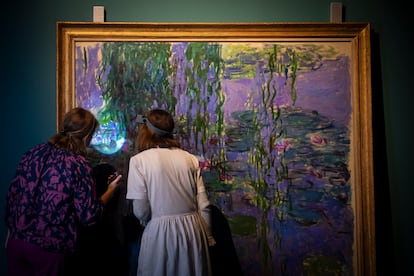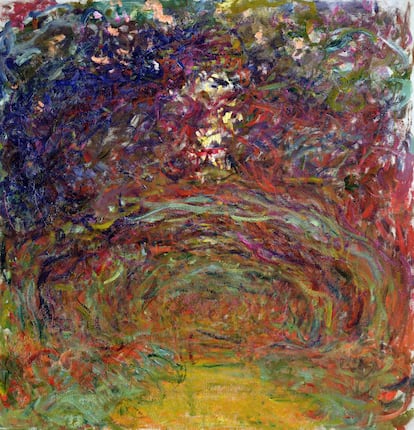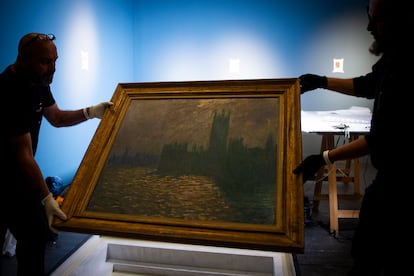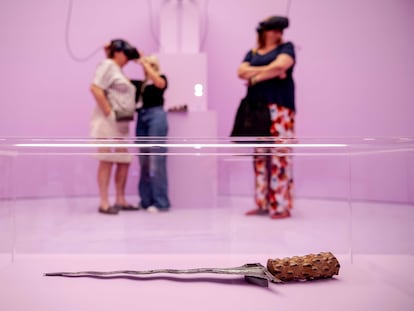The last Monet: Almost blind, abstract and undervalued
Late in life and suffering from cataracts, the French painter took his painting to gestural, non-figurative extremes

Formless yellow, blue and green strokes create spots of color across three meters of canvas. There is little distinction between above and below in the painting Wisteria (1919-1920), by Claude Monet (1840-1926), which is much more abstract than other works he created during the Impressionist period in the last three decades of the 19th century. The oil painting belongs to his last period, when the artist suffered cataracts, which required surgery and affected the production of pieces that were not valued until long after his death.

Wisteria is one of the works that best represents the last phase of the French painter. It is one of more than 40 that will be exhibited starting next Thursday at Madrid’s CentroCentro in the exhibition Monet: Masterpieces from the Musée Marmottan Monet. They come from the Marmottan, a 16th century mansion located eight kilometers from the center of Paris, which contains the largest and most important collection of the French painter, thanks largely to the donation of his son, Michel, in 1966. Michel, who did not have direct descendants, enriched the Marmottan collection with his father’s personal collection, made up largely of those final works that testify to his continued painting despite the ailment in his eyes.
The cataracts arrived in the midst of the artist’s research in his gardens in Giverny. The impressionist, increasingly distant from the human figure, was fascinated by his new surroundings, according to Aurélie Gavoille, one of the curators of the exhibition and conservation assistant at the Marmottan. The art historian Philippe Piguet comments that this rural town, where the Seine and Epta rivers meet and where Monet arrived in 1883, impressed him by “the quality of its light, due to the kind of microclimate that is created in the area by its topography and the great presence of water.”
The symptoms of cataracts — loss of clarity in vision, alteration in the perception of colors — did not stop Monet’s work, but they did affect both Monet’s practice and the results. “It was organized when he began to have problems with the tones in 1912. The palette always had the colors in the same order,” says Gavoille. The curator says that the artist’s color range was reduced and was dominated by browns, reds and yellows, “more violent, daring colors.” Several paintings from that period, now on display, feature those pigments with filmy, gestural brushstrokes, as in Rose Path (1920-1922), Japanese Bridges (1918-1924), Weeping Willow (1918-1919) and The Garden of Giverny (1922-1926).
The historian Emmanuelle Amiot-Saulnier writes in a text for the exhibition that the advance of the disease is very evident in the Japanese Bridges series. “The right eye loses the natural perception of depth typical of binocular vision, as reflected in the series, which is notable for its lack of depth.”

Monet was reluctant to have surgery. “It scared him because he was a painter, and he thought he was going to lose the intensity of the colors,” says Gavoille. He finally underwent the operation in 1923, “thanks to his friend Georges Clémenceau, who was also then president of the Council of France.” Gavoille says that Monet was never at risk of going blind: “Perhaps he was terrified of not being able to see anything and finding himself in blackness. Black was also a color that he totally refused to use in his paintings, but the operations went very well.” Amiot-Saulnier has a more dramatic interpretation: “He experienced all the restlessness of a progressive and unequal blindness in both eyes, to the point that in 1922 he had a tenth of vision left in the left, while on the right he only perceived movement.”
The ocular condition made Monet distance himself from contours, vanishing points, details, and other academic precepts, even though he rejected the abstract movement, says Gavoille. “There is a change in his way of painting, in the technique. The end of the exhibition is dedicated to that search for a more refined style of painting.” His Water Lilies series (1916-1919) is one of the most popular works of that final period: in 2014 one of these canvases was auctioned for 40 million euros. They are the apotheosis of his career after studying and reproducing the aquatic plants in small formats. They dispense with any perspective and eliminate the horizon so that the viewer is immersed in the mirror of water.

The general curator of the exhibition and curator of the Marmottan, Sylvie Carlier, notes that Monet’s last production was little understood and appreciated by his contemporaries. It was revalued in the second half of the 20th century and highlighted mainly in the United States with exhibitions at the MoMA and the recognition of the abstract expressionists, “in particular Jackson Pollock (1912-1956), who was greatly inspired by it for his own technique,” says Carlier. Amiot-Saulnier agrees: “Monet, in short, granted Jackson Pollock the right to exist and to allow himself to be absorbed by his dripping like a shaman in a trance. It gave the painters of the Color Field movement the possibility of considering the canvas as a field of colors, not of shapes, as Mark Rothko (1903-1970) predicted, to absorb the viewer.”
Monet’s final period went from being the least valued — the six-meter panels went for the same price as a small Cézanne or Renoir, around €209,000 (around $223,600), according to historian Marianne Mathieu — to being the focus of exhibitions in the US. The MoMA not only exhibited works from this period but also acquired them, and critics such as William C. Seitz described them as the starting point of a new pictorial trend that paved the way for the avant-garde of the 20th century.

The exhibition does not only include Monet’s last works: jewels such as Portrait of Poly (1886), which the impressionist made for a lobster fisherman who helped him carry his materials, are also on display. “Poly wanted to have the painting as a kind of reward, but Monet always refused to give it to him because he thought it was a very good portrait, and he didn’t make many. He even hung it in his living room,” says Gavoille. There is also Parliament. Reflections in the Thames (1905), in which he uses the structure as an excuse to paint the reflection of the water, and The Promenade, Argenteuil (1870-1875), which depicts Monet’s wife with one of his sons. But they all lead up to his later years’ exploration of the light that, paradoxically, cost him his eyes. As Cezanne said of him: “Monet is only an eye, but my God, what an eye!”
Sign up for our weekly newsletter to get more English-language news coverage from EL PAÍS USA Edition









































